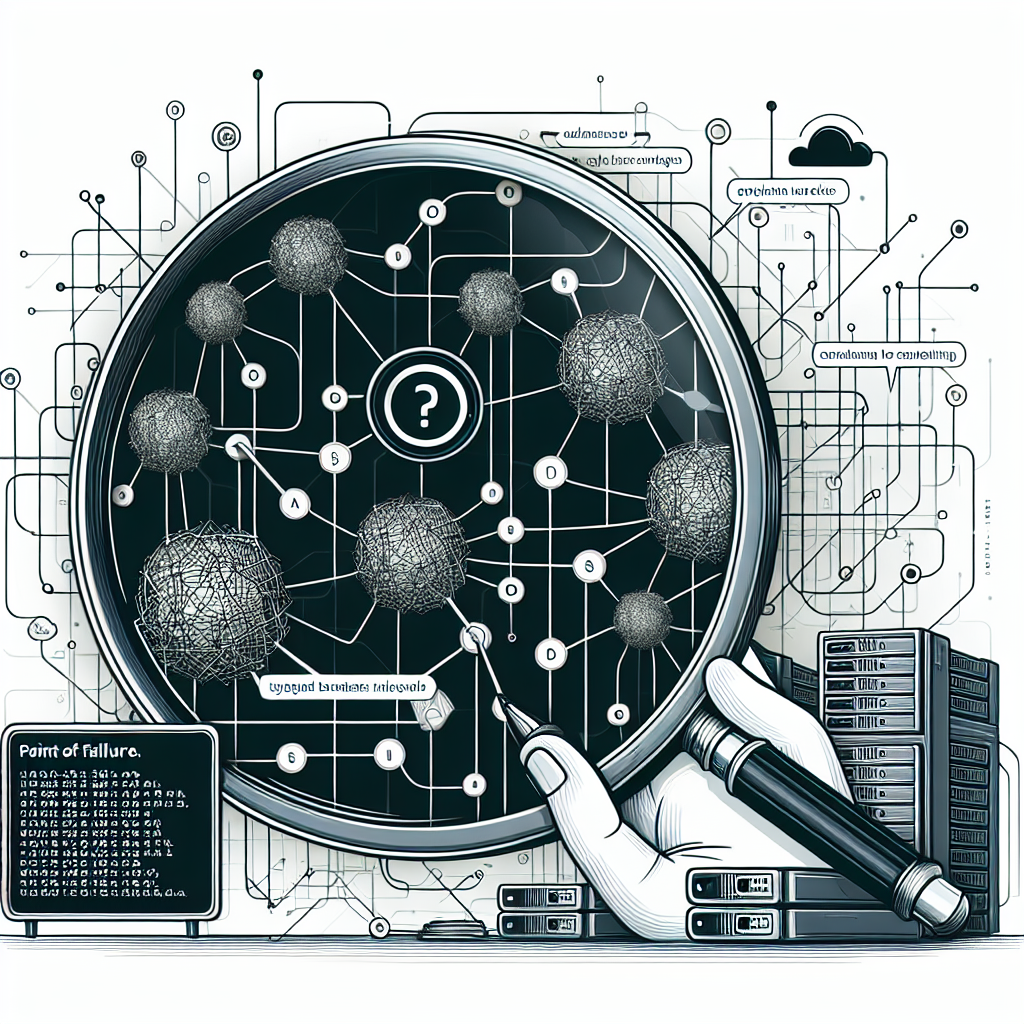Your cart is currently empty!
Tag: Data Center Root Cause Analysis

From Problem to Solution: How Root Cause Analysis Can Transform Data Center Management
Data centers are the backbone of modern businesses, housing all the critical technology infrastructure needed to keep operations running smoothly. However, managing a data center can be a complex and challenging task, with numerous potential issues that can arise at any given time. From power outages to cooling system failures, data center managers must be prepared to tackle a wide range of problems to ensure uninterrupted service.One powerful tool that data center managers can use to address these issues is root cause analysis. Root cause analysis is a systematic process for identifying the underlying cause of a problem, rather than just addressing the symptoms. By digging deeper to uncover the root cause of an issue, data center managers can develop more effective solutions that prevent the problem from recurring in the future.
When it comes to data center management, root cause analysis can be particularly valuable. By identifying and addressing the root causes of common data center issues such as power failures, equipment malfunctions, and cooling system problems, data center managers can improve the overall reliability and efficiency of their facilities.
For example, let’s say a data center experiences a power outage that results in downtime for critical systems. Instead of simply restoring power and moving on, a data center manager could use root cause analysis to determine why the outage occurred in the first place. Perhaps the outage was caused by a faulty piece of equipment, inadequate backup power systems, or a lack of proper maintenance procedures. By identifying the root cause of the outage, the data center manager can implement targeted solutions to prevent similar incidents from happening in the future.
In addition to addressing immediate problems, root cause analysis can also help data center managers proactively identify potential issues before they escalate into major problems. By analyzing data center performance metrics and trends, managers can pinpoint areas of weakness and take corrective action before problems arise.
Overall, root cause analysis is a powerful tool that can help data center managers transform their operations from reactive to proactive. By identifying and addressing the underlying causes of issues, data center managers can improve the reliability, efficiency, and overall performance of their facilities. In today’s fast-paced business environment, where downtime can have serious financial implications, the ability to quickly and effectively address data center issues is more important than ever. Root cause analysis provides data center managers with the tools they need to stay ahead of potential problems and keep their operations running smoothly.

Maximizing Data Center Reliability Through Root Cause Analysis
In today’s rapidly evolving digital landscape, data centers play a crucial role in ensuring the smooth operation of businesses and organizations. These facilities house the servers, networking equipment, and storage systems that store and process vast amounts of data, making them the backbone of modern technology infrastructure. As such, maximizing data center reliability is essential to ensure uninterrupted operations and maintain business continuity.One effective way to enhance data center reliability is through root cause analysis (RCA). RCA is a systematic process for identifying the underlying causes of problems or failures within a system. By conducting a thorough analysis of incidents or issues that occur within a data center, IT teams can uncover the root causes of these issues and implement corrective actions to prevent them from recurring in the future.
One of the key benefits of RCA is its ability to identify systemic issues that may be contributing to data center downtime or performance degradation. By tracing the root cause of an incident back to its origins, IT teams can uncover underlying weaknesses in the data center infrastructure, such as equipment failures, network issues, or configuration errors. Addressing these root causes allows organizations to proactively mitigate potential risks and strengthen the overall reliability of their data center operations.
Furthermore, RCA can help organizations improve their incident response and resolution processes. By identifying the root cause of an issue, IT teams can develop targeted solutions to address the underlying problem, rather than simply applying temporary fixes to symptoms. This proactive approach not only reduces the likelihood of future incidents but also streamlines the incident resolution process, minimizing downtime and ensuring a more efficient data center operation.
To effectively implement RCA in a data center environment, organizations should follow a structured approach that includes the following key steps:
1. Identify the problem: Define the issue or incident that needs to be investigated, such as a server outage, network disruption, or data loss.
2. Gather data: Collect relevant information and data related to the incident, including logs, performance metrics, and configuration details.
3. Conduct analysis: Analyze the data to identify potential root causes of the problem, using techniques such as fault tree analysis, fishbone diagrams, or the “5 Whys” method.
4. Develop solutions: Based on the root cause analysis, develop and implement corrective actions to address the underlying issues and prevent future occurrences.
5. Monitor and evaluate: Continuously monitor the data center environment to ensure that the implemented solutions are effective and that no new issues arise.
By following these steps and incorporating root cause analysis into their data center management practices, organizations can enhance the reliability and resilience of their data center operations. This proactive approach not only minimizes downtime and disruptions but also improves overall performance and efficiency, ultimately leading to a more robust and reliable data center infrastructure.

Root Cause Analysis: A Key Tool for Maintaining Data Center Security
In today’s digital age, data centers play a critical role in storing and managing vast amounts of information for businesses and organizations. With the increasing reliance on technology, it has become more important than ever to ensure the security and integrity of data center operations. One key tool that can help in this endeavor is Root Cause Analysis (RCA).Root Cause Analysis is a systematic process used to identify the underlying causes of problems or incidents within a system. By investigating the root causes of issues, organizations can implement effective solutions to prevent them from recurring in the future. In the context of data center security, RCA can help identify vulnerabilities and weaknesses in the infrastructure that could potentially lead to data breaches or cyber attacks.
Data center security is a top priority for businesses, as a breach can have severe consequences such as financial losses, reputational damage, and legal implications. By conducting RCA, organizations can proactively address security issues before they escalate into major incidents. This proactive approach can help in maintaining a secure and resilient data center environment.
There are several benefits to using Root Cause Analysis in data center security. Firstly, it helps in identifying the root causes of security incidents, rather than just addressing the symptoms. This enables organizations to implement targeted and effective solutions that address the underlying issues. Secondly, RCA can help in improving the overall security posture of the data center by identifying potential vulnerabilities and weaknesses in the system. By addressing these root causes, organizations can strengthen their security defenses and reduce the risk of security breaches.
In addition, Root Cause Analysis can also help in enhancing incident response capabilities. By understanding the root causes of security incidents, organizations can develop more effective response strategies and procedures. This can help in minimizing the impact of security incidents and reducing downtime in the event of a breach.
To effectively implement Root Cause Analysis in data center security, organizations should follow a structured approach. This involves gathering relevant data and information, conducting a thorough analysis of security incidents, identifying root causes, and developing corrective action plans. It is important to involve key stakeholders such as IT security teams, data center operators, and management in the RCA process to ensure a comprehensive and collaborative approach.
In conclusion, Root Cause Analysis is a key tool for maintaining data center security. By identifying and addressing the root causes of security incidents, organizations can strengthen their security defenses, reduce the risk of breaches, and enhance incident response capabilities. By prioritizing security and implementing proactive measures, organizations can ensure the integrity and confidentiality of their data center operations.

The Power of Root Cause Analysis in Preventing Data Center Downtime
Data center downtime can have a significant impact on businesses, leading to lost revenue, decreased productivity, and damaged reputation. In today’s digital age, where data is king, any interruption in data center operations can have far-reaching consequences. One of the most effective ways to prevent data center downtime is through the use of root cause analysis.Root cause analysis is a systematic process used to identify the underlying causes of problems or failures. By digging deep into the root causes of an issue, organizations can implement targeted solutions to prevent similar incidents from occurring in the future. In the context of data centers, root cause analysis can be a powerful tool in identifying and addressing issues that could lead to downtime.
One of the key benefits of root cause analysis in preventing data center downtime is that it helps organizations move beyond simply addressing symptoms of a problem. Instead of just fixing the immediate issue, root cause analysis allows organizations to identify the underlying factors that contributed to the problem in the first place. By addressing these root causes, organizations can implement more effective and long-lasting solutions that can prevent downtime from occurring in the future.
Root cause analysis also helps organizations to prioritize their efforts in preventing data center downtime. By identifying the root causes of past incidents, organizations can focus their resources on addressing the most critical issues that are likely to lead to downtime. This targeted approach allows organizations to make the most of their resources and ensure that they are addressing the most pressing concerns first.
Furthermore, root cause analysis can help organizations to improve their overall data center operations. By identifying and addressing root causes of downtime, organizations can implement changes to their processes, procedures, and infrastructure that can enhance the reliability and resilience of their data centers. This proactive approach can help organizations to prevent downtime before it occurs, rather than simply reacting to incidents as they happen.
In conclusion, the power of root cause analysis in preventing data center downtime cannot be overstated. By identifying and addressing the underlying causes of problems, organizations can implement targeted solutions that can prevent downtime from occurring in the future. Root cause analysis helps organizations to prioritize their efforts, improve their operations, and ultimately ensure the continued availability and reliability of their data centers. By making root cause analysis a key part of their data center management practices, organizations can proactively prevent downtime and minimize the impact of any incidents that do occur.

Driving Efficiency: Using Root Cause Analysis to Optimize Data Center Operations
In today’s digital age, data centers play a crucial role in storing and processing vast amounts of information for businesses and organizations. With the ever-increasing demand for data storage and processing power, it is essential for data center operators to continuously strive for efficiency in their operations.One effective method for optimizing data center operations is by using root cause analysis. Root cause analysis is a systematic process for identifying the underlying causes of problems or inefficiencies in a system. By identifying and addressing the root causes of issues, data center operators can improve the overall efficiency and performance of their facilities.
One common issue that data center operators face is downtime. Downtime can be costly for businesses, as it can lead to lost revenue, decreased productivity, and damage to a company’s reputation. By conducting root cause analysis, data center operators can pinpoint the underlying causes of downtime, whether it be equipment failure, power outages, or human error.
Once the root causes of downtime have been identified, data center operators can take proactive measures to prevent future incidents. This may involve implementing redundancy measures, upgrading equipment, or providing additional training for staff members. By addressing the root causes of downtime, data center operators can minimize disruptions to their operations and ensure that their facilities are running efficiently.
In addition to downtime, root cause analysis can also be used to optimize energy consumption in data centers. Data centers are notorious for their high energy usage, with cooling systems and servers contributing to a significant portion of electricity consumption. By conducting root cause analysis, data center operators can identify inefficiencies in their energy usage, such as overcooling, underutilized servers, or inefficient hardware.
By addressing these root causes, data center operators can implement energy-saving measures, such as adjusting cooling settings, consolidating servers, or upgrading to more energy-efficient hardware. These measures can not only reduce energy costs for data center operators but also contribute to a more sustainable and environmentally friendly operation.
Overall, root cause analysis is a powerful tool for optimizing data center operations. By identifying and addressing the root causes of problems and inefficiencies, data center operators can improve the overall efficiency, reliability, and sustainability of their facilities. By continuously striving for efficiency through root cause analysis, data center operators can stay ahead of the curve in an increasingly competitive and demanding industry.

Digging Deeper: The Role of Root Cause Analysis in Data Center Troubleshooting
In the fast-paced world of data centers, troubleshooting and resolving issues quickly and effectively is essential to maintaining uptime and ensuring optimal performance. One key tool in the arsenal of data center technicians is root cause analysis (RCA), a methodical approach to identifying the underlying cause of problems rather than just addressing symptoms.Root cause analysis is a systematic process that involves investigating and analyzing the events leading up to an issue in order to determine the primary cause. By identifying the root cause, technicians can implement targeted solutions that address the problem at its source, rather than simply applying temporary fixes that may only mask the symptoms.
When it comes to troubleshooting in data centers, root cause analysis plays a crucial role in ensuring that issues are resolved efficiently and effectively. By following a structured approach to problem-solving, technicians can avoid wasted time and resources on ineffective solutions and prevent recurring issues from occurring.
One of the key benefits of root cause analysis in data center troubleshooting is its ability to prevent downtime and minimize disruptions. By pinpointing the root cause of an issue, technicians can address the underlying problem and implement solutions that prevent similar issues from occurring in the future.
Additionally, root cause analysis can help data center technicians identify patterns and trends in issues, allowing them to proactively address potential problems before they escalate into major issues. By analyzing data and trends, technicians can identify common causes of issues and implement preventive measures to avoid future problems.
In conclusion, root cause analysis is an essential tool in the toolkit of data center technicians when it comes to troubleshooting and resolving issues. By taking a systematic approach to problem-solving and identifying the root cause of issues, technicians can ensure that data centers operate smoothly and efficiently, minimizing downtime and disruptions. By digging deeper and understanding the underlying causes of problems, data center technicians can implement targeted solutions that address issues at their source, leading to a more reliable and resilient data center environment.

Uncovering the Source: How Root Cause Analysis Can Improve Data Center Performance
Data centers are the backbone of today’s digital economy, serving as the nerve center for businesses large and small. With the increasing reliance on technology and data, ensuring the optimal performance of data centers is crucial for organizations to maintain their competitive edge. However, when issues arise within a data center, it can be challenging to pinpoint the underlying cause and address it effectively.This is where root cause analysis comes into play. Root cause analysis is a systematic process for identifying the underlying sources of problems or issues within a system, such as a data center. By uncovering the root causes of performance issues, organizations can implement targeted solutions to improve data center performance and prevent future problems from occurring.
One of the key benefits of root cause analysis is its ability to provide a comprehensive understanding of the factors contributing to data center performance issues. Instead of simply addressing the symptoms of a problem, root cause analysis delves deeper to uncover the underlying issues that are causing performance degradation.
For example, if a data center is experiencing frequent downtime, a root cause analysis may reveal that the issue is due to inadequate cooling systems or insufficient power supply. By addressing these root causes, organizations can implement solutions such as upgrading cooling systems or increasing power capacity to prevent future downtime and improve overall data center performance.
In addition to identifying and addressing specific issues, root cause analysis can also help organizations improve overall data center efficiency and reliability. By understanding the root causes of performance issues, organizations can implement proactive measures to prevent problems from occurring in the first place. This can include regular maintenance and monitoring of critical systems, as well as implementing best practices for data center management.
Furthermore, root cause analysis can help organizations make informed decisions about future investments in their data center infrastructure. By identifying the underlying causes of performance issues, organizations can prioritize investments in areas that will have the greatest impact on improving data center performance. This can help organizations maximize the return on their investment in data center infrastructure and ensure that their data center is able to meet the growing demands of their business.
In conclusion, root cause analysis is a valuable tool for improving data center performance and ensuring the reliability and efficiency of critical systems. By uncovering the source of performance issues and implementing targeted solutions, organizations can enhance the performance of their data center, prevent future problems, and make informed decisions about their data center infrastructure. With the increasing importance of data centers in today’s digital economy, root cause analysis is an essential process for organizations looking to maximize the value of their data center investments.

Maximizing Uptime: The Benefits of Data Center Root Cause Analysis
Data centers are the backbone of today’s digital world, serving as the nerve center for storing, processing, and transmitting vast amounts of data. With the increasing reliance on technology for business operations, maximizing uptime in data centers has become a top priority for organizations. One effective way to achieve this goal is through root cause analysis.Root cause analysis is a systematic process used to identify the underlying reasons for problems or failures within a system. In the context of data centers, root cause analysis involves investigating the root causes of downtime incidents or performance issues to prevent them from recurring in the future.
By conducting root cause analysis, data center operators can gain valuable insights into the factors that contribute to downtime, such as equipment failures, human error, software bugs, or environmental factors. This information allows them to address the root causes of these issues and implement corrective measures to prevent similar incidents from happening again.
The benefits of data center root cause analysis are numerous. One of the key advantages is improved uptime and reliability. By identifying and addressing the root causes of downtime incidents, data center operators can reduce the frequency and duration of outages, ensuring that critical IT services remain available to users.
In addition to minimizing downtime, root cause analysis can also lead to cost savings. Downtime in data centers can result in lost productivity, revenue, and customer trust. By proactively identifying and addressing the root causes of downtime, organizations can avoid these costly disruptions and maintain business continuity.
Furthermore, root cause analysis can help data center operators enhance the efficiency and performance of their infrastructure. By identifying and resolving underlying issues that affect system performance, organizations can optimize their data center operations and ensure that resources are used effectively.
Another benefit of root cause analysis is improved decision-making. By understanding the root causes of downtime incidents, data center operators can make more informed decisions about infrastructure investments, maintenance schedules, and operational procedures. This can lead to better resource allocation and improved overall performance.
Overall, data center root cause analysis is a valuable tool for organizations seeking to maximize uptime, reliability, and efficiency in their data center operations. By identifying and addressing the root causes of downtime incidents, organizations can proactively prevent future issues and ensure that their critical IT services remain available and reliable.

Getting to the Bottom of It: Data Center Root Cause Analysis Explained
In the world of data centers, downtime is the enemy. Every minute of downtime can cost a company thousands or even millions of dollars in lost revenue and damage to their reputation. That’s why when an issue arises in a data center, it is crucial to quickly identify and address the root cause in order to prevent further disruptions.This process is known as root cause analysis, and it is a critical component of data center management. Root cause analysis involves systematically investigating the underlying reasons for an issue in order to prevent it from happening again in the future. By identifying and addressing the root cause of a problem, data center managers can improve the reliability and resilience of their infrastructure.
So, how does root cause analysis work in a data center setting? The process typically involves several key steps:
1. Identify the issue: The first step in root cause analysis is to identify the issue that is causing disruptions in the data center. This could be anything from a hardware failure to a software bug to a human error.
2. Gather data: Once the issue has been identified, data center managers must gather as much data as possible about the problem. This may involve analyzing logs, performance metrics, and other relevant information to pinpoint the root cause.
3. Analyze the data: After collecting the necessary data, data center managers must analyze it to determine the root cause of the issue. This may involve looking for patterns or trends in the data that could shed light on the underlying problem.
4. Develop a solution: Once the root cause has been identified, data center managers can work on developing a solution to address the issue. This may involve making changes to hardware or software configurations, implementing new processes, or providing additional training to staff.
5. Implement the solution: Finally, data center managers must implement the solution and monitor its effectiveness. This may involve testing the new configuration, tracking performance metrics, and making adjustments as needed.
By following these steps, data center managers can effectively get to the bottom of issues in their infrastructure and prevent future disruptions. Root cause analysis is a powerful tool for improving the reliability and resilience of data centers, and it is an essential part of any data center management strategy.

